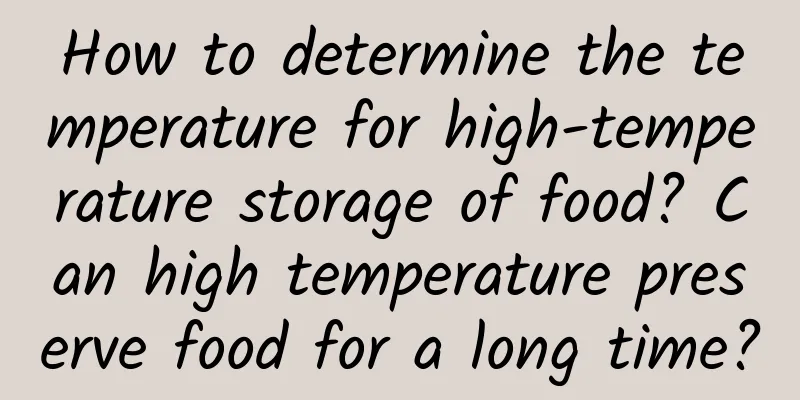How to determine the temperature for high-temperature storage of food? Can high temperature preserve food for a long time?

|
We usually store food in a refrigerator where the temperature is lower than room temperature, because bacteria are more likely to grow under high temperature conditions, and food is more likely to spoil. However, some foods can also be stored at high temperatures, mainly to kill some bacteria. How to determine the temperature of high-temperature storage foodThe heating temperature of normal pressure sterilization is generally controlled below 100℃.It is generally used for sterilizing liquid foods, such as milk, vegetable and fruit juices below PH4, and beer. Generally speaking, heating at 63°C for 30 minutes is a low-temperature pasteurization method, while heating at 72°C for 15 seconds is a high-temperature short-time pasteurization method. The temperature of pressure sterilization is generally controlled at 100~121℃ (absolute pressure is 0.2 MPa).It is generally used for meat products and low-acid canned foods. The heating temperature and time generally vary with the material, shape, can size and storage time of the food in the can. The general temperature of ultra-high temperature instantaneous sterilization is 137.8℃, which lasts for 2 seconds and then quickly drops to room temperature.This method can not only kill a large number of bacteria, but also kill the spores of some high-temperature resistant thermophilic Bacillus, while maintaining food quality to the greatest extent. It is mostly used for milk disinfection. The frequency of electromagnetic waves used for microwave sterilization is generally 300~30000 MHz.Use different frequencies according to the water content, thickness or volume of the food. Microwave sterilization can retain more active ingredients and nutrients in food, and it is fast and convenient. Can high temperature preserve food for a long time?High temperatures can prevent some foods from spoiling, but they cannot keep them from spoiling for long periods of time. For the sake of freshness and taste, food should not be stored for too long. When the temperature reaches a certain level, the high temperature will destroy the enzymes, liposomes and cell membranes in the organism, and the protoplasm structure will be inhomogeneous, resulting in the coagulation of microbial proteins and the cessation of all metabolic activities in the cells. At the same time, the high temperature will also inactivate the enzymes in the food, ultimately achieving the purpose of preserving the food. Normal pressure sterilization, pressure sterilization, ultra-high temperature instantaneous sterilization and microwave sterilization are all high-temperature preservation of food. How did people preserve food in ancient times without refrigerators?The first common method of preservation is drying.For example, pancakes have very little water content, so they are not easy to spoil. The same is true for Xinjiang baked naan. Microorganisms need water to reproduce, so drying is a very good way to preserve food. Instant noodles, for example, do not need preservatives because they have little water content. The second way is pickling.For example, bacon, ham, salted duck eggs, candied fruit, etc., these foods are either low in water or have a lot of salt or sugar added, and sometimes they are smoked, so they are not easy to deteriorate. Salt and sugar can produce a very high osmotic pressure, just like people cannot drink seawater, and most microorganisms cannot withstand such osmotic pressure. The third method is fermentation.For example, foods such as kimchi, sauerkraut, fermented glutinous rice, and fermented bean curd contain a large number of natural fermentation microorganisms, which can prevent other microorganisms from invading and are therefore not easy to spoil. The same is true for yogurt, which does not require preservatives. In addition, some food preservation techniques are still in use today, such as storing fruits and vegetables in cellars, which have low temperatures, no light, and less oxygen, so they can be preserved for a long time. In short, the reproduction of microorganisms requires appropriate conditions such as temperature, moisture, salt, etc. Many foods that claim to be without preservatives are simply not suitable for the reproduction of microorganisms. |
<<: How to make food for the elderly How to regulate their daily diet
>>: Is electric blanket safe for heating? How to use electric blanket safely?
Recommend
When should a transvaginal ultrasound be performed?
When women suffer from gynecological diseases, th...
Introduction to Scarred Uterine Rupture
In daily life, women should pay attention to thei...
What should pregnant women do if their fingers peel?
Many people have the problem of peeling skin on t...
Women have fever at night and are normal during the day
During the day, various functions of the human bo...
How to distinguish between menstruation and hemorrhage
It is well known that menstruation is a barometer...
Can I still take folic acid after pregnancy?
Many couples who are preparing for pregnancy will...
Does contractions every few minutes mean that you are about to give birth?
"Ten months of pregnancy, one day of deliver...
Symptoms of menopause in a 49-year-old woman
Women will gradually enter menopause when they ar...
What causes uterine polyps?
Many women find uterine polyps after examination,...
Will corpus luteum rupture heal on its own?
Progesterone is very important for women. Most wo...
Why are red grapes so sweet? When should I eat red grapes without gaining weight?
Red grapes are a very delicious fruit. They are v...
How to wear underwear with small breasts?
There are many women with big breasts in life, bu...
7 Myths About Men's Health: Do You Believe Them?
Author: Xue Qingxin, registered dietitian Reviewe...
Sacubitril/valsartan can treat heart failure and lower blood pressure. What should you pay attention to when using it?
A friend of mine suffers from high blood pressure...
Can uterine fibroids be treated in their early stages?
A large proportion of people in society have no k...









![[Medical Q&A] Why did my child suddenly start crying because his arm hurt when I was leading him to climb the stairs?](/upload/images/67f0fcbd5bdd8.webp)